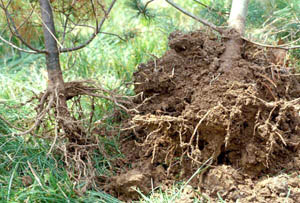White Pine Decline Evident | |
|---|---|
| June 19, 2007 | |
|
The word “decline” is frequently used to label a disease situation in which many factors are involved to cause slow deterioration of plant health. Decline also indicates a situation in which we cannot pinpoint one factor or pathogen as the cause of the problem. White pine has its decline disease, appropriately named white pine decline. The unseasonably warm temperatures in early spring and recent dry spells in much of the state seem to have helped intensify symptoms on trees with this problem. White pine problems seem to be present throughout the state, especially in central and southern areas. Symptoms vary but generally include some pattern of needle yellowing or browning, small needle size, stunted growth, sparse foliage, shriveled bark on branches or trunk, sap exudate on branches, and, in some cases, death of the tree. Affected trees have ranged in size from 2 feet to more than 20 feet, indicating that trees of any size could be affected. The image shows typical foliar symptoms.  White pines as understory trees thrive in the cool, moist, welldrained soils of Wisconsin forests. They grow with intermittent success in Illinois landscapes. Many of the problem trees we have seen in Illinois are situated on clay sites or exposed to the elements (planted in new housing developments or used as windbreaks). It is likely that site stress has contributed to the decline of these trees. Both flooding and drought can add to the problem, causing additional root injury. Of the many white pines examined over the years at the Plant Clinic, the common factor seems to be root decline. Few live, fibrous, white roots have been found on white pines in decline; and in most cases, fungal pathogens have not been found. The image shows roots of a healthy white pine (right) next to a root system from a tree with white pine decline.  The healthy roots have many fibrous roots that hold onto the soil. Roots may be in decline for many reasons. Some factors contributing to white pine decline include clay or poorly drained soil, compaction, heat stress to roots, drought, flooding, deep planting, girdling roots, and sudden extremes in temperature and moisture. Pines prefer acidic soil, so the high-pH soils in Illinois may also be part of this complex. In a few cases, oozing sap near the soil line has been associated with Procerum root rot, a root decline caused by a weak pathogen known to invade stressed trees. The healthy roots have many fibrous roots that hold onto the soil. Roots may be in decline for many reasons. Some factors contributing to white pine decline include clay or poorly drained soil, compaction, heat stress to roots, drought, flooding, deep planting, girdling roots, and sudden extremes in temperature and moisture. Pines prefer acidic soil, so the high-pH soils in Illinois may also be part of this complex. In a few cases, oozing sap near the soil line has been associated with Procerum root rot, a root decline caused by a weak pathogen known to invade stressed trees. Often, trees with white pine decline do not recover. Because there is nothing infectious in these trees, waiting to see if the trees recovers does not jeopardize the health of nearby white pines. Watering helps (except in cases of flooding stress), as does the use of natural mulch (such as shredded bark) over the root system. Still, without adequate root mass, plants cannot use the available water quickly enough to replace what is used by the foliage. The result is sudden browning or offcolor needles and death of branches. |